Tasting the Vendange in Bordeaux
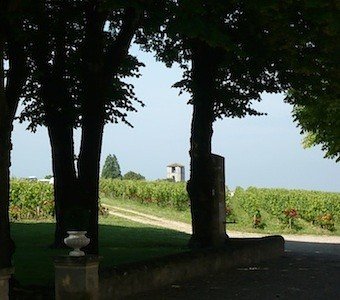
Thu 31 Oct 2013
As much as I love my house in the Bordeaux region in the summer, I think September and October are the finest months in southwestern France. Pourquoi? Well, it’s the grape harvest, or vendange, of course. Everyone who lives around me grows vines, whether they are the neighbors next door who give their grapes to the local co-op (where you can buy a bottle for 3 euros) or the neighbors slightly farther afield in Saint-Émilion who produce wines that sell for hundreds of dollars a bottle. Everyone seems to be excited, busy and anxious during the vendange.
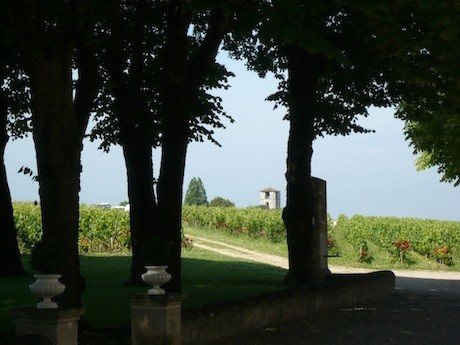
Bordeaux vines ripe and ready in Saint-Émilion.
It’s my dream to help out with a harvest one year. I’m hoping to do so this year, even if just for a day, at my friend Claire’s winery, Font-Vidal, which is just down the road from us. Her family, which has been making wine for many years, produces a good red Bordeaux for about 5–8 euros a bottle, depending on the year.
Of course there is no doubt that after a day, or even a half day, of picking grapes, I’ll be exhausted and aching and wondering what I have gotten myself into. Nothing a few glasses of her Bordeaux won’t cure, hopefully sipped outside at a big table with my fellow workers. Until I get to experience my overly romanticized version of the vendange, I’ll have to make due with tastings and exploring the various châteaux near and far in the region.
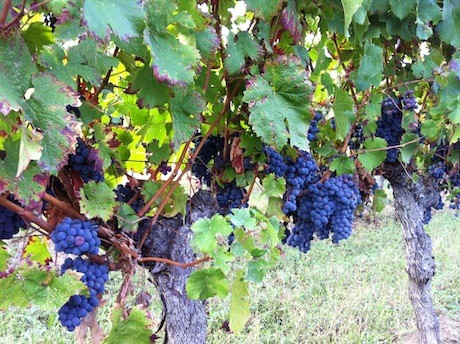
My favorite places to visit in the area start with the medieval town of Saint-Émilion. Here, there are many wine shops where you can buy wine and have it shipped home; Ets Martin is our personal favorite. You must also stop and smell the roses—at the end of each grape row are rosebushes to act as early defense against pests and disease.
One of the most beautiful châteaux to explore is Clos Fourtet, right on the edge of town. While the building itself is not as grand as some of the others, the underground caves are breathtaking. There are 16 kilometers of caves underneath the home and working vineyard. About 10,000 bottles are kept there, some of each year’s harvest for personal consumption and to hold and sell later. One could probably hide in the caves for years and not be found.
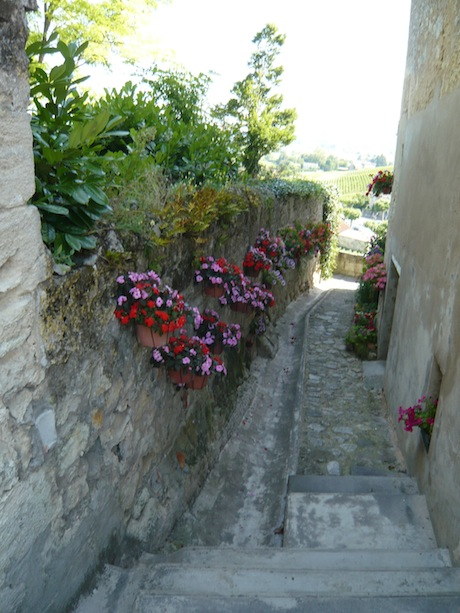
A little lane in Saint-Émilion.
The quarry was excavated for the coveted limestone that Saint-Émilion sits on top of; the limestone was used for all the buildings in the area, including our little farmhouse. It is also part of the secret as to why Saint-Émilion wines are so special and famous—you want a grapevine to work for its nutrients, so rocky soil is ideal.
Of course, the best part of the experience of visiting a château is the tasting part at the end. Clos Fourtet won’t disappoint, as it’s a grand cru classé, the highest rated of the Saint-Émilions. But unlike the überfamous Château Ausone, it is still somewhat affordable at $60 per bottle for the lesser years.
Another unique place worth visiting is Clos des Jacobins, run by Thibaut and Magali Decoster. The house was previously a priory for Jacobin monks and is quite beautiful. Part of it is still used as a residence. Exploring this tiny place feels very intimate and special, and the formal gardens are divine. Hubert de Boüard from Château Angélus is a consultant for the winery here, and you’ll appreciate his touch as you sample.
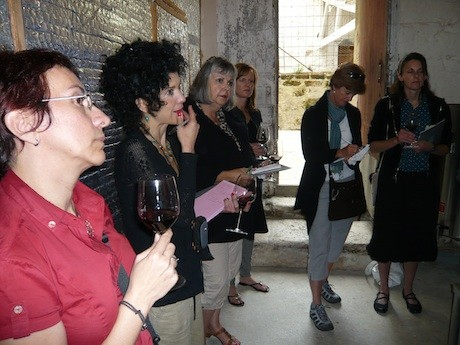
A wine tasting in Saint-Émilion on a girls’ trip.
We bought a few bottles ourselves, and you can’t forget the richness of it on your lips, as well as its uncharacteristic black label.
Our favorite restos in Saint-Émilion are Chai Pascal for a quick bite at lunch or dinner and sumptuous wines by the glass, and Les Giron’dines at 5, rue des Girondins, which is absolutely delicious and open all year—the terrace is particularly lovely in summer. Expect some very fine food served in a relaxed atmosphere.
We also adore L’Huitrier Pie on rue de la Porte Bouqueyre. It serves oysters and fish fresh from the Atlantic, which is just a few kilometers away.
While you are in Saint-Émilion, remember to get tickets for the trip of the famous underground church from the tripist office. Saint-Émilion has quite a history; it was founded in the eighth century by a hermit, a monk named Émilion, who lived in solitude, praying in the caves of the area. He was sainted, hence the name. The underground church, carved out of the limestone quarry underground, is one of only four in the world. It will capture you with its history and magic, as will the entire region.
Did you know this article is a sneak peek of our magazine? For more great articles like this one, subscribe to our digital magazine, Girls’ Guide to Paris ET PLUS.
Related Links
Font-Vidal
Ets Martin
Clos Fourtet
Clos des Jacobins
Chai Pascal
L’Huitrier Pie
Saint-Émilion tripist office